Last October, Attorney General William Barr drew attention for a fiery speech he gave at the University of Notre Dame. Barr asserted that “virtually every measure of social pathology continues to gain ground” in America–measures such as illegitimacy, violence, and suicide rates. This has happened because Americans are losing their self-control. People are naturally “subject to powerful passions and appetites” and thus to “licentiousness.” In a free society, restraining licentiousness requires an “internal controlling power.” Only religion, faith in “an authority independent of men’s will . . . a transcendent Supreme Being,” can inhibit these passions. In the last 50 years, Barr contended, we have experienced a loss of inhibition because “the steady erosion of our traditional Judeo-Christian moral system.” Organized forces of secularism have promoted the “destruction” of religion, especially through government by, for example, restricting prayer in school, legalizing abortion, and inserting LGBT curricula into the schools.
Moral duty, Barr concluded, required using the Department of Justice to protect religious freedom. That would restore Americans’ self-control and thus reverse the tide of pathology. “We cannot have a moral renaissance unless we succeed in passing to the next generation our faith and values in full vigor.”
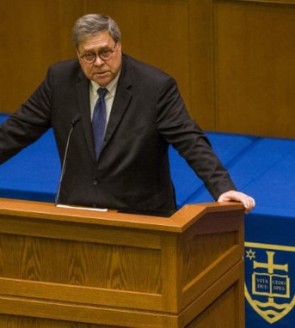
Source: South Bend Tribune
The howls from the Left over this speech focused on the specter of Barr using the DOJ’s powers to weigh in on the conservative side of the great Culture Wars. My concern here is simply to ask, How factually correct is Barr’s story? His is a sweeping, powerful, and consequential description of recent American history. Is it true?
I address Barr’s argument from first cause to final result: Are religion and faith in decline and, if so, because of secularists’ attacks? Does religion provide and is it necessary for free people’s self-control? Has Americans’ self-control weakened? Has there been increasing social pathology and, if there has, is weakening self-control the explanation?
I approach this topic with some empathy. Barr is a serious Catholic; I am an active member (and past president) of my synagogue. We are on the same side of the divide between organized religion and mobilized secularists. However, the historical facts are clear and they are not on Barr’s side.
Is religion in decline and, if so, is it because of secularists’ attacks?
Whether Americans’ religiosity is in decline has long been debated. (See several previous posts.[1]) Some indicators of traditional American religious behavior suggest yes, it has declined. Notably, fewer Americans today declare a religious affiliation, attend services, or show a commitment to organized religion.[2] However, Americans’ expressions of faith–their beliefs about the supernatural, be it an Abrahamic God or other forces, and about “spirituality”–have been pretty stable or even rising.[3] One alternative interpretation to Barr’s is that Americans’ religiosity, if broadly defined to include, say, Eastern forms, has not so much declined as changed.
Nonetheless, let us assume for the sake of argument that Americans’ religiosity has fallen in ways Barr describes. Certainly, expressed religious identification is down: From 1973 to 1991, only about 6 percent of respondents to the American General Social Survey (GSS) picked “no religion” when asked, “What is your religious preference? Is it Protestant, Catholic, Jewish, some other religion, or no religion?” In 2018, 23 percent did.[4] Barr’s explanation for religious decline is that secularists have successfully waged war against religion: “The problem is not that religion is being forced on others. The problem is that irreligion and secular values are being forced on people of faith” by both institutions and mass culture.
Barr brings no evidence in support of this claim, no evidence, for example, that being taught evolution in the schools or watching television dissolves faith. To the contrary, evidence suggests that any religious weakening, such as the substantial increase in the Nones, resulted not from oppression by secularists, but rather from disillusionment with organized religion. The “New Atheists” have made a lot of noise, but the proportion of admitted atheists, though doubling, remains minuscule, rising from 2 percent in the 1991 GSS to about 5 percent in 2018.[5] There are–and also were generations earlier–probably more American atheists than surveys suggest, but there is no evidence of any substantial growth in their representation.
The deeper change is that young Americans have been put off by the leaders of organized religion who have taken bellicose political positions on issues of sexual morality, individual freedom, and other cultural issues. This has led increasingly many to publicly disclaim any religious identity even if they retain religious sensibilities.[6] The irony is clear: The very change that Barr decries, a fall in traditional religious involvement, has been largely produced by the sort of culture war-waging he himself exhibited at Notre Dame.
Another irony is that Barr’s own Catholic church has experienced more defections than have other faiths. A greater proportion of Americans who were raised as Catholics have rejected that identity than of those who were raised as Protestants. Attendance at church services has plunged among people who still call themselves Catholics, while actually increasing among people who say they are Protestants.[7] The Vatican’s positions against birth control and abortion and its insistence on male-only clergy and clergy celibacy alienate many young Catholics. Barr does not discuss this crisis. Yet more striking, Barr never mentions another reason for Catholics’ alienation: sexual abuse revelations. To blame schools’ inclusion of LGBT issues for the “destruction” of religion and never even mention pedophile priests is grossly disingenuous.
Is religion necessary for a free people’s self-control against licentiousness?
Barr’s affirmative claim here is striking because it flies in the face of some straightforward evidence. Among free, western, affluent peoples, Americans are the most or are among the most religious.[8] This should make Americans among the least “licentious,” the least “lacking legal or moral restraints” (Merriam-Webster). Yet: the murder rate in the United States is about five times greater than murder rates in western nations that are notably non-religious like Denmark, the Netherlands, and the United Kingdom.[9] American drug and alcohol addiction rates are about double those in such secular countries. And our incarceration rates are five to ten times higher.
Additionally, within the U.S., the more religious a state’s residents are, the higher that state’s rates of homicide, incarceration, and STDs.[10] These correlations alone cannot, for various reasons, prove that religiosity increases licentiousness,[11] but one would have expected from Barr’s speech that, at the very minimum, the simple correlation between religiosity and licentiousness would have gone the other way.
Has Americans’ self-control weakened?
Because religion is in retreat and the “internal controlling power” it provided thus weakened, Barr argues, so Americans’ resistance to Old Adam is failing. It is hard to assess trends in something as subtle as self-control apart from looking at trends in its supposed consequences–which I reserve for the next section–but there is evidence.
We can plunge straight into the largest cauldron of licentiousness that concerns Barr: sex. Over recent decades the GSS has asked Americans to report their attitudes about sex and, confidentially, to report their sexual behaviors. Since the 1970s, Americans have increasingly approved of both premarital sex and homosexuality–evidence for Barr’s assertion. But they have remained solidly disapproving of teen-age sex and extramarital sex–evidence against Barr’s assertion. In the early 1990s, 8 percent of Americans said that they could imagine a situation in which extramarital sex was not wrong; in the last several years, 9 percent did. The trends in sexual attitudes are less about licentiousness than they are about endorsing individual freedom of choice–but choice limited by possible harm to others.[12]
If self-control has indeed weakened, we might expect that Americans would be sexually more active and less inhibited. However, Americans these days actually report having sex less frequently than did Americans in the early 1990s. Moreover, Americans are no more likely now than about 30 years ago to report having multiple sex partners or having cheated on their spouses. A reader might be skeptical that survey respondents are, even in confidential responses, honest about such matters. But if Barr were right that Americans are losing their inhibitions, we should have seen more and more bragging about sex over the last three decades; we don’t.[13] The data on sex show no growing loss of self-control.
How and how well Americans have managed their impulses might be hard to discern in such crude numbers. Understanding self-control may require deeper and more nuanced historical research. Fortunately, there is such research: the social history of emotions.[14]
The consensus in that field is that over the 19th and early 20th centuries, more Americans developed greater control over their explosive, antisocial emotions. Schools, factories and office jobs, law enforcement, and evangelical religions taught people to restrain their aggressive and vulgar impulses and to instead nurture sympathy and collegiality. The mid- to late 20th century is more complex. On the surface American culture increasingly valued expressiveness and informality–blue jeans, long hair, doing “your own thing.” However, such liberalization went, not with a loosening of inhibitions, but with an internalization of inhibitions (a description, by the way, which is consistent with Freud and Foucault.)
As external rules and regulations loosened, individual Americans had to–and did–take on a greater burden of self-governance. Examples: With fewer and weaker rules of formal etiquette, Americans had to navigate social interactions more self-consciously. With more mixing of men and women in public, Americans had to exercise more sexual self-restraint. (Despite the current #MeToo scandals, women are safer in public today than in earlier eras). Most Americans have learned to repress any taste for engaging in or enjoying displays of brutality. (This was message of Steven Pinker’s best-selling history, Angels of Our Better Nature.) And then there is political correctness. However annoying, it calls on people to censor themselves lest they injure the feelings of others. (For more on the history of “self-fashioning,” see Made in America.)
Again, Barr is wrong. Contemporary Americans are no less and are probably more self-restraining than were their parents and grandparents.
Has “virtually every measure of social pathology continue[d] to gain ground”?
Barr is partly right here. Some measures have gained ground, others have lost ground. Distinguishing between the two says much about Barr’s argument. Let’s begin with a couple of behaviors that, puzzlingly, Barr does not address and then turn to his catalog of pathologies.
First, crime: Rates of homicides, violent crime in general, and property crime were high or rising in the 1970s through 1990s, but they have plummeted sharply since, reaching low points not seen since the 1950s.[15] Second, early sex: Teenage pregnancy, birth, and abortion rates have dropped tremendously since about 1990 and one reason is that teenagers are having sex later than they used to.[16] Both trends, unmentioned by Barr, contradict him.
Barr’s own list of pathologies starts with illegitimacy, that is, births out of wedlock. He is definitely correct that the proportion of births by unwed mothers grew rapidly over the last couple of generations, rising from about 12 percent of all births in the early 1970s, peaking around 2010, and then leveling off in the low 40 percent range.[17] However, this rise occurred not because young women became more lustful; as mentioned above, teen sex and pregnancy are down since at least the 1990s. The key reason for the rise in births to unwed mothers is that women increasingly waited longer to get married than women had before. In 1970, the average American woman married for the first time at age 21, but in 2019 the average American woman married at age 28. That delay roughly doubled the years of being “at risk” of pregnancy. (I should add that premarital sex is not new. About half of young American women in the early, pre-pill 1960s were not virgins; by around 1980, the probability of being a virgin at first marriage had already reached its current low level, under about 10 percent). Moreover, Americans increasingly refused to marry just because of a pregnancy; “shotgun marriages” have nearly disappeared.[18] The rise in births to the unwed is not about the weakening of self-control, but about the weakening of external controls such as norms that women should marry young or that pregnant women must marry.
Barr’s mention of the “wreckage of the family” presumably refers to divorce. Actually, divorce rates are down and declining, mainly because the threshold for getting married in the first place has risen. Young Americans increasingly wait to attain financial stability and to test their partners before forming a “capstone” marriage.[19]
Critically, rocky trends in American family life are class-specific. College graduates have experienced modest changes to their chances of marrying, breaking up, or raising children in fragmented families. Cohabitation in place of marriage, serial partnership, and spells of single-motherhood are much more typical of and have grown much more among non-graduates.[20] I will return to this class issue shortly.
Barr refers to “record levels of depression and mental illness.” Whether they really are at record levels is uncertain, largely because the means of assessing the mental states of a population over time are so difficult and our attention to mental illness has escalated so rapidly.[21]
Barr is only partially right about “soaring suicide rates.” Rates of teen suicide attempts have not gone up; rates of successful teen suicides have gone up and down since 1970 and then recently up again. The suicide rates of adult Americans dropped from 1986 to 2006 but then rose substantially, especially in rural America.[22] Suicides provde mixed evidence for Barr at best, since any upsurge seems specific to only the most recent years, not to the full era of supposed religious decline.
Barr is definitely right about a “deadly drug epidemic.” Deaths by drug overdose rose exponentially in the U.S. from 1970 through the 2010s.[23] Indeed, many scholars have described an upsurge, since around 2000, in all “deaths of despair,” combining deaths by suicide and alcoholism with deaths by drug overdose. So great was this deathly upsurge that it caused an unusually extended pause in white Americans’ growing life expectancy.[24]
In overview, two key observations about social pathology emerge: First, over the last generation or so, some kinds of pathology have worsened, some have healed, and some have not changed much. Roughly speaking, the ones that have gotten worse tend to be not expressions of unbridled licentiousness, as Barr would have it, but rather expressions of disappointment. Pathologies of unrestrained id and ego, like sexuality and crime, have largely declined, while those of despair, like drug addiction, have risen.
The second key observation is about class: The rising pathologies have largely affected Americans of lesser education. Americans who are college graduates have been hardly touched,[25] even though they are likelier to be the religious skeptics whom Barr thinks lack self-control.[26] Economic misfortunes and the resulting despair are more likely the sources of social pathologies than is religious dis-inhibition.
The point about class is underlined by looking at Barr’s last pathology, “immense… suffering.” The GSS tracked Americans’ unhappiness for over 40 years. There is not much change in those numbers, but what there is suggests an increase in the proportion saying they are “not too happy” only for non-college graduates.[27]
In Closing
Barr’s grand theory of Americans’ moral collapse turns out to be, in all its particulars, either unsupported or, usually, contradicted by historical facts. Organized secularists have not destroyed Americans’ faith, although more Americans have become alienated from organized religion; they became alienated because of changes in organized religion. Religiosity does not seem necessary for individual self-control and Americans’ level of self-control has not weakened over the generations; indeed, the opposite is likelier. The trends in Americans’ pathologies are mixed. Many, notably vicious crimes, have declined in recent decades. What have persisted or worsened are pathologies of disappointment, not of evil impulses unleashed.
Barr’s speech is puzzling theologically. In insisting on an inborn temptation to evil, and that individuals must practice individual self-control out of fear of being damned by “a transcendent Supreme Being,” and that society has fallen away from a purer time, the speech sounds much more like one of the jeremiads Puritan ministers unleashed on their congregants centuries ago than it does like a Catholicism traditionally more tolerant of human failing. The underlying individualism in Barr’s account is also very Puritan Protestant. Social ills emerge from individual willfulness. The role of the community is to instill fear of God to check that willfulness. An alternative approach to social ills would see them as rooted in social arrangements. Of course, that is not the ideological direction Barr and his administration want to take.
Furthermore, as a serious Catholic, Barr should be wary of the state coming to support religion, because in America that has usually meant indoctrination into Protestantism. Generations of Catholics fought the state, for example, by trying to get the King James Bible out of the public schools. In 1844, their opposition to Bible reading led to days of nativist mob attacks against Catholic institutions in the Philadelphia region.[28] What is more, much of contemporary disaffection from religion stems precisely from its being too closely intertwined with politics and the state.
Barr’s speech at Notre Dame may have been intended to lay out the social understanding that undergirds the administration’s actions regarding church and state. If so, it is feeble foundation.
NOTES (Lots of Notes) ——————————————————————————-
[1] See earlier posts: “Faith Endures” ; “Declaring You’re a “None’”; “Latest News on “No Religion””; “Spiritual and/or Religious”.
[2] The figure below uses the GSS to display the trends in various indicators. Note here that rates of declaring no religious affiliation and of never attending services have steadily risen since the 1980s. But strong adherents remained strong adherents–see Hout (2017) for a good overview. On loss of confidence in organized religion, see also this Gallup report. For more on disaffiliation, see note 6 below.
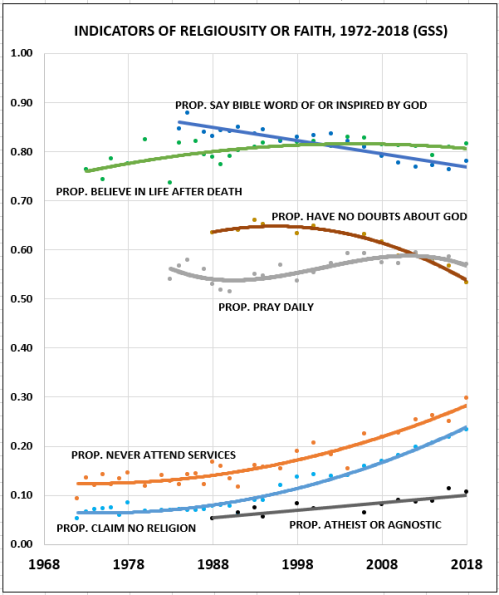
[3] The figure in note 2 shows mixed but undramatic trends: modest declines in the proportion of Americans saying that the Bible is the literal word of God or inspired by God and saying that they believe in God with no doubts; a modest increase in the proportion of Americans saying that they believe in life after death; no change in proportion saying that they pray at least daily; and a small increase in the proportion saying that they do not believe in God or that there is no way to know about God’s existence. Note also that “belief in ghosts has soared in recent decades, from one in ten Americans to one in three. Moreover, young Americans are about twice as likely as old Americans to say they have consulted psychics, believe in ghosts, and believe in haunted houses” (from “Boo!”).
[4] See graph above in note 2. Other surveys show similar trends in “Nones.” Pew results show a rise to 17% in those who said their religion was “nothing in particular,” which, added to Pew’s atheists and agnostics, roughly matches the GSS’s “Nones.”
[5] Agnostics (can’t know if there is a God) rose from 4% up to 6% ( the GSS “GOD” item). Pew results are similar: Atheists up to 5% and agnostics to 4% in 2018-19. See also Gullickson (2018). For a longer historical view, see the post, “Atheist Evangelism.”
[6] For scholarly works on religious disaffiliation as a reaction to the politicized culture wars, see Hout and Fischer (2002 and 2014), Putnam and Campbell (2010), and Margolis (2018, some of which is reported by the “538″ website).
[7] On Catholics: The graph below shows rates of departure from childhood religion between 1973 and 2018. Catholics left at a greater rate than Protestants or Jews and that difference widened over the period.

The next figure shows what has happened in reported church attendance rates. Among those who still labeled themselves Catholic reports of attending at least twice a month plummeted, while among those who still labeled themselves Protestant, they rose. (Both trends are pushed upward by the growing drop-out rates shown in the previous figure, but the contrast remains.)

For more on the fate of Catholics, see, e.g., Pew, “U.S. Catholics” (2017) and Gallup reports (here and here.)
[8] Americans still remain exceptionally religious. See, e.g., Schnabel and Bock (2017) and these earlier posts: “Still Under God” and “Is the U.S. No Longer Religiously Exceptional?”
[9] International data are available here.
[10] The following figure shows the association, across the 50 states, of levels of religiosity (as determined in mid-2010s Pew surveys) and rates of four kinds of social pathologies: homicide, incarceration, STDs (specifically chlamydia), and deaths by drug overdose. With the exception of the last item, the more religious a state’s residents, the higher that state’s rates of pathology.
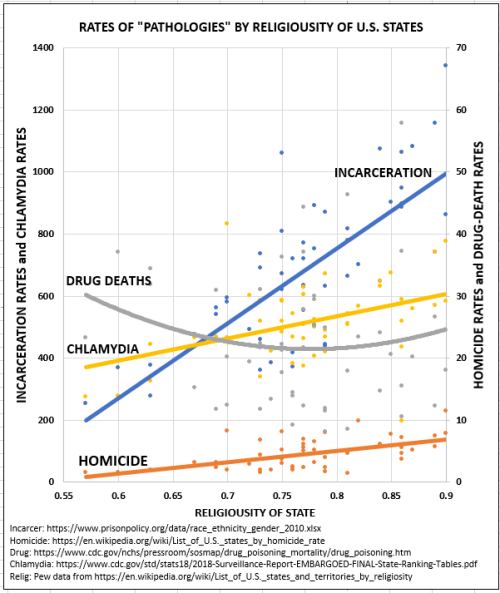
[11] These data do not establish that religiosity causes licentiousness because, among other things, they show ecological correlations, there are no controls (e.g., for demographics or rates of poverty), and causal direction is untested.
[12] The figure below shows trends in Americans’ attitudes about sex. The trends fall into two types, I would suggest: Attitudes about allowing individuals to lead whatever sex lives they wish so long as no one is harmed–premarital sex (GSS’s PREMARSX variable) and homosexuality (HOMOSEX)–and attitudes about sex that could involve injury to self or others–teen sex (TEENSEX) and extramarital sex (XMARSX). Americans became far more liberal about the first category of sex but remained sternly conservative about the second category. A 2013 post on the topic is “Sexual License, Sexual Limits.” (The item about extramarital sex combines the “never wrong” with the “sometimes not wrong,” because the proportion who said “never wrong” ranged from 3% in the mid-1970s to about 2% in the mid-2010s. A moment’s reflection suggests that these attitudes about extramarital sex–70 to 77 percent said “always wrong”–are quite stringent, since they would constrain, say, spouses of severely disabled or Alzheimer patients from having a sex life.)

A note about homosexuality: A recent study shows no difference in homosexual behaviors or self-description between men who came into sexual maturity in the 1980s and those who matured in the 2000s (5 percent of each, roughly). The pattern is more complex for women: Many more of the latest cohort compared to the first cohort, roughly from 20 percent versus 10 percent, reported ever having a same-sex encounter, but there was no difference in having had one in the previous year. See England et al (2016).
[13] The following chart shows responses of GSS interviewees regarding sexual behavior. Reported sexual frequency (SEXFREQ) declined (and controlling for age doesn’t change that). The proportion who reported more than one sex partner in the last year (PARTNERS) or in the last five years (PARTNRS5) did not change. And the proportion admitting to ever having “sex with someone other than your husband or wife while you were married” (EVSTRAY; restricted to those who had ever been married) did not change overall. (Among respondents 60+ in age, there was a modest upward trend.)
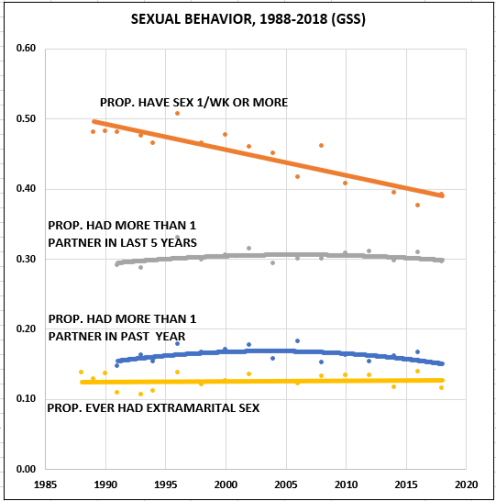
[14] On the history of emotions, see many books by Peter Stearns, also, for example: Pfister and Schnog (eds.), Inventing the Psychological: Toward a Cultural History of Emotional Life in America; Eustace, Passion in the Gale; Kasson, Rudeness and Civility; Lystra, Searching the Heart; Schlesinger, Learning How to Behave; the popular best-seller, Pinker, Angels of Our Better Nature.
[15] This first graph shows trends in homicide, violent crime in general, and property crime in general. It draws from police reporting to the FBI in the Uniform Crime Reports. The second figure is drawn from large surveys of Americans.
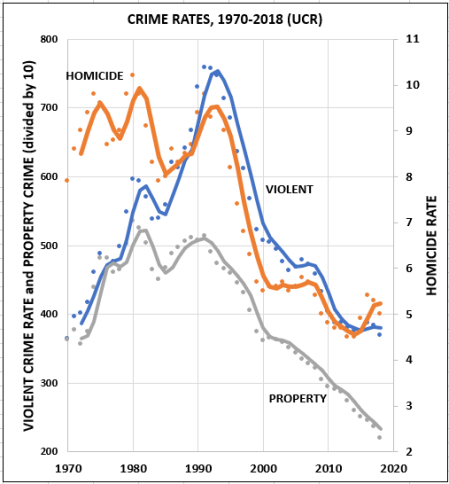

[16] Teen sex is down, from National Health Statistics.

[17] Unwed births are up as reported in the Senate Joint Economic Committee Report, “Love, Marriage, and the Baby Carriage.” See, also, data from Child Trends.

[18] Shotgun marriages are down: Also from the Senate Report in note 17.
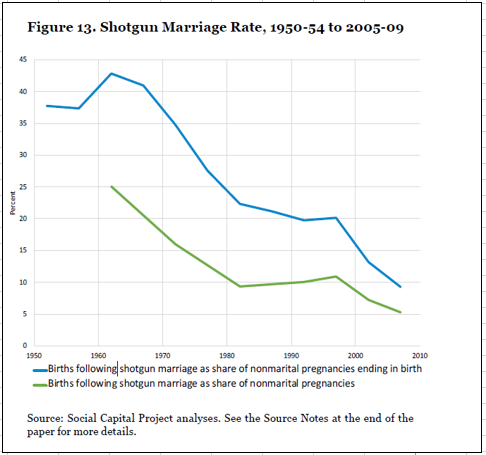
[19] “Young Americans increasingly wait to attain financial stability and to test their partners before a ‘capstone’ marriage’” (Cherlin, “Degrees of Change”). See also Cohen, “The Coming Divorce Decline.”
[20] On how different classes experienced the family turmoil of the late 20th century, see Ch. 4 in Fischer and Hout, Century of Difference (2006) and many sources more recently, including Lundberg et al, “Family Inequality”; an excellent essay in The Atlantic by Victor Tan Chen; and a 2015 column I wrote.
[21] On the complications of studying trends in mental illness, see these blog posts: “Depressing Comparisons” and “Psychological Labeling … and Enabling?” On mixed evidence about recent trends, see Child Trends, “Trends in young adult depression”; Weinberger et al, “Trends in depression prevalence”; Clarke et al, “The Social Structuring of Mental Health” on cohort declines; and the American Psychological Association 2019 stress report, which finds that “overall stress levels have not changed significantly over the past few years” (p. 1). The most one could claim is a modest increase, if any, in symptoms.
[22] Suicide. The source for the figure below is here. Recent reports stress the rise since 1999 (e.g., here), but recent rates are about what they were 30 years ago. Over the longer course of American history, there’s been no general secular trend (see suicide line in figure for note 24 below; also: pp. 231ff of Made in America and the blog post, “Suicide Boom?”).
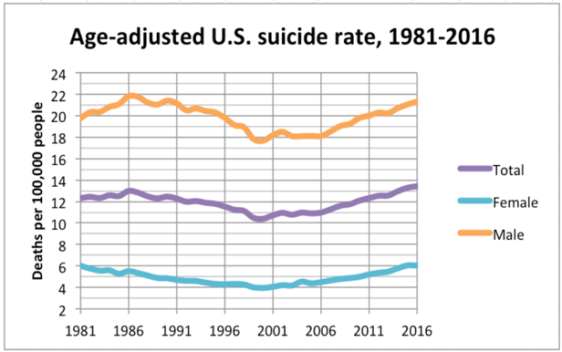
[23] This graph shows deaths per 100,000 due to drug overdoses:
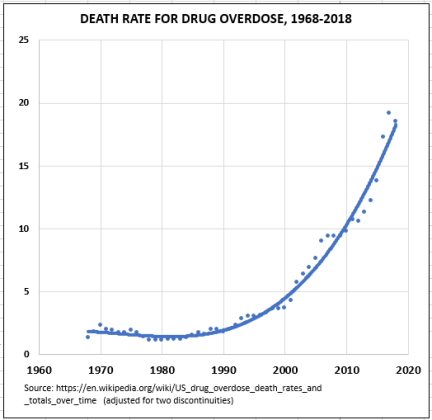
[24] The Senate Joint Economic Committee’s “Love” Report includes this graph on deaths of despair. A critical source is Case and Deaton (2017).

On life expectancy, see the unusual leveling off for whites in the graph below.

[25] Generally, the problematic trends described earlier in this essay show up as worse for the less educated, such as those regarding family life. For the widening gaps regarding suicide, see Phillips and Hempstead (2017). Below is a “despair by education” figure from Case and Deaton (2017). See also Siddiqi, “Growing Sense” (2019).
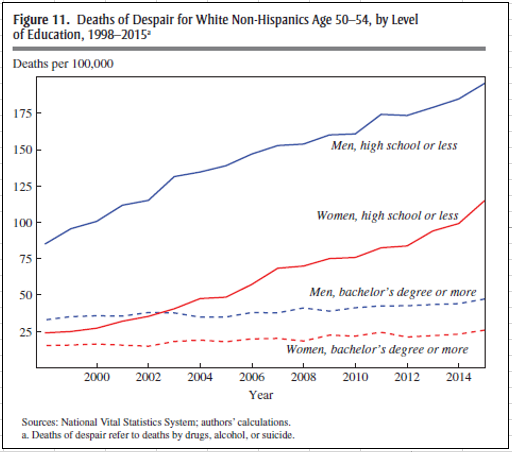
[26] In the GSS, 2010 through 2018, 60% of respondents with less than a bachelor’s degree said that they “believed in God without a doubt,” while 49% of those with at least a bachelor’s degree did.
[27] Unhappiness trends by education in the graph below. In addition, see also Figure 11 in Siddiqi, “Growing Sense” (2019) and Hout, “Money and Morale” (2015) which show an even greater widening of the happiness gap by education.

[28] On Philadelphia, see “Nativist Riots of 1844.” On the Bible Wars, see earlier post, “Bible Readings.”

